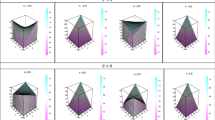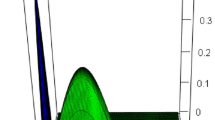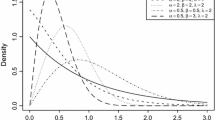Abstract
Generally modelling lifetime data is carried out using probability distributions with the aid of reliability functions such as hazard rate, mean residual life, etc. In the present work an alternative approach is proposed by considering bivariate copulas instead of bivariate distributions. We define the analogues of reliability functions that are expressed in terms of copulas and study their properties. The results of the study are applied to case of the copulas of a bivariate exponential family of distributions.


Similar content being viewed by others
References
Bassan, B., Kochar, S., Spizzichino, F.: Some bivariate notions of IFR and DMRL and related properties. J. Appl. Probab. 39, 533–544 (2002)
Bassan, B., Spizzichino, F.: Stochastic comparisons for residual lifetimes and Bayesian notions of multivariate ageing. Adv. Appl. Probab. 31, 1078–1094 (1999)
Berg, D.: Copula goodness-of-fit testing: an overview and power comparison. Eur. J. Finance 15, 675–701 (2009)
Csörga̋, S., Welsh, A.: Testing for exponential and Marshall–Olkin distributions. J. Stat. Plan. Inference 23, 287–300 (1989)
D’Agostino, R.B.: Goodness-of-fit-techniques, vol. 68. CRC Press, Boca Raton (1986)
Fang, K.-T., Fang, H.-B., Rosen, D.V.: A family of bivariate distributions with non-elliptical contours. Commun. Stat. Theory Methods 29, 1885–1898 (2000)
Galambos, J., Kotz, S.: Characterizations of Probability Distributions. Springer, Berlin (1978)
Genest, C., Rémillard, B., Beaudoin, D.: Goodness-of-fit tests for copulas: a review and a power study. Insur. Math. Econ. 44, 199–213 (2009)
Genest, C., Rivest, L.-P.: Statistical inference procedures for bivariate Archimedean copulas. J. Am. Stat. Assoc. 88, 1034–1043 (1993)
Georges, P., Lamy, A.-G., Nicolas, E., Quibel, G., Roncalli, T.:. Multivariate survival modelling: a unified approach with copulas. Available at Social Science Research Network (2001). http://gro.creditlyonnais.fr/content/rd/homecopulas.htm
Gumbel, E.J.: Bivariate exponential distributions. J. Am. Stat. Assoc. 55, 698–707 (1960)
Johnson, N.L., Kotz, S.: A vector multivariate hazard rate. J. Multivar. Anal. 5, 53–66 (1975)
Kaishev, V.K., Dimitrova, D.S., Haberman, S.: Modelling the joint distribution of competing risks survival times using copula functions. Insur. Math. Econ. 41, 339–361 (2007)
Louzada, F., Suzuki, A.K., Cancho, V.G., Prince, F.L., Pereira, G.A.: The long-term bivariate survival FGM copula model: an application to a brazilian HIV Data. J. Data Sci. 10, 511–535 (2012)
Nair, N.U., Nair, V.K.R.: A characterization of the bivariate exponential distribution. Biom. J. 30, 107–112 (1988)
Nair, N.U., Sankaran, P.G.: A family of bivariate exponential distributions and their copulas. Sankhya B 76, 1–18 (2014)
Navarro, J., Spizzichino, F.: Comparisons of series and parallel systems with components sharing the same copula. Appl. Stoch. Models Bus. Ind. 26, 775–791 (2010)
Nelsen, R.B.: An Introduction to Copulas, 2nd edn. Springer, Berlin (2006)
Pellerey, F.: On univariate and bivariate aging for dependent lifetimes with Archimedean survival copulas. Kybernetika 44, 795–806 (2008)
Romeo, J.S., Tanaka, N.I., Pedroso-de Lima, A.C.: Bivariate survival modeling: a Bayesian approach based on copulas. Lifetime Data Anal. 12, 205–222 (2006)
Saunders, R., Laud, P.: The multidimensional Kolmogorov goodness-of-fit test. Biometrika 67, 237–237 (1980)
Shaked, M., Shanthikumar, J.G.: Stochastic Orders. Springer, Berlin (2007)
Zahedi, H.: Some new classes of multivariate survival distribution functions. J. Stat. Plan. Inference 11, 171–188 (1985)
Acknowledgements
We thank the referee and the editor for the constructive comments. The third author thanks Department of Science and Technology, Government of India for providing financial support.
Author information
Authors and Affiliations
Corresponding author
Appendices
Appendix A: Proof of Proposition 3.2
Since \(G_1(u,v) =\dfrac{{A_1 (u,v)}}{{A_1 (u,1)}}\), we have \(G_1(p,1)=1\) and
The properties \(C(1,v)=v\) and \(C(u,0)=0\) are obvious. Further,
Condition (iii) implies that for \(v_2 \ge v_1\),
which is the same as
and thus C(u, v) is a copula.
Appendix B: Proof of Proposition 3.3
Assume (3.9). Then by direct calculation,
which is of the form (3.10). On the other hand, if we assume that (3.10) holds then formulas (3.6) and (3.7) lead to the functional equation
which is equivalent to
The solution is
giving
Substituting into (3.6) and (3.7), we recover the copula (3.9). This completes the proof.
Appendix C: Proof of Proposition 3.4
To prove the necessary part, we note that for the Clayton survival copula,
and
so that (3.11) holds. To prove the converse part, we observe that (3.12) is an Archimedean copula with generator \(\phi (u)=\theta (u^{\frac{-1}{\theta }}-1)\). From Theorem 4.3.8 in Nelsen [18], for Archimedean copula with generator \(\phi \),
for almost all u,v in I.
Using
(C1) becomes
for all u, v.
The solution of the above functional equation is
where k is a constant that may depend on \(\theta \). Also k is less than zero since \(\phi \) is decreasing. Solving (C2) with the boundary condition \(\phi (1)=0\) and setting \(k=-1,\)
and accordingly C is a Clayton survival copula.
Appendix D: Proof of Proposition 4.1
Differentiating (4.1) with respect to u,
Also
or
Substituting in (D1),
Similarly
Integrating (D2) from u to 1 and (D3) from v to 1 we have (4.3) and (4.4).
Appendix E: Proof of Proposition 4.2
Condition (i) follows from the identity
Now
It is easy to see that \(C(1,v)=v\) and \(C(u,0)=0\). Also
by (ii).
Condition (iii) implies that for \(v_2 \ge v_1\)
which is equivalent to the 2-increasing property of C(u, v). Thus C(u, v) is a copula.
Appendix F: Proof of Proposition 4.3
The necessary part of the theorem follows by direct calculations using (3.9) in (4.5) and (4.6). This gives
which is of the form (4.9). We prove the converse part by assuming (4.9). Equations (4.7) and (4.8) yield after some algebra
This leads to the functional equation
which is true for all u, v. This happens if and only if (F2) is a constant, say \(\dfrac{1}{\beta }\), \(\beta >0\). Thus from (F2),we obtain
and
Substituting \(K_1(v)\) and \(K_2(u)\) in (F1), we obtain the Gumbel–Barnett survival copula.
There exist some identities connecting \((G_1,G_2)\), \((M_1,M_2)\) and \((L_1,L_2)\). From (D2) and (D3)
and
Differentiating (4.5)
or
Using the definition of \(G_1\),
Similarly
Also \((L_1,L_2)\) is related to \((M_1,M_2)\) by the identities
and
Rights and permissions
About this article
Cite this article
Nair, N.U., Sankaran, P.G. & John, P. Modelling bivariate lifetime data using copula. METRON 76, 133–153 (2018). https://doi.org/10.1007/s40300-018-0135-5
Received:
Accepted:
Published:
Issue Date:
DOI: https://doi.org/10.1007/s40300-018-0135-5




